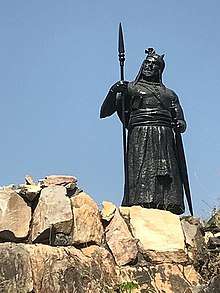Hakim Khan Sur
Hakim Khan Sur An ethnic Pathan, (also known as Hakim Khan Sur Pathan) was a Pashtun warrior and a general in Rana Pratap's army. He fought with him in the Battle of Haldighati and died in 1576. In Haldighati Battle, he commanded an army of Afghans who were against the rising power of Mughal Empire.
| Hakim Khan Sur | |
|---|---|
 | |
| Born | Delhi |
| Died | Haldighati |
| Dynasty | Sur |
| Father | Khaisa Khan Suri |
| Mother | Bibi Fatima (step-mother) |
| Religion | Muslim |
Biography
Hakim Khan Suri was a member of the Sur dynasty and was a descendant of Sher Shah Suri, the founder of the Sur Empire.[1]
Hakim Khan was a seasoned Sur, who had his own axe to grind against the imperial motives of the Mughals. He found in Pratap an energetic, chivalrous and bold veteran hero, for whom the Mughal imperialism was a nuisance too.[2]
The Battle of Haldighati is widely but wrongly perceived as a Hindu-Muslim conflict, but this is not the case. Both armies had a mix of Hindus and Muslims. This was a struggle between the Mughal imperialism and Mewar.[3] Whereas Hakim Khan Suri led the vanguard for Rana Pratap, Akbar's army was commanded by the Rajput chief of Jaipur, Man Singh I and half the Mughal army was composed of Rajput soldiers.[4] Hakim Khan was part of the battle to exact revenge from the Mughals for the defeat of Sikandar Shah Suri, his forefather.[4]
Hakim Khan fighting with Maharana Pratap and Man Singh I along with Akbar, clearly establishes the fact that the battle of Haldighati was fought against imperialistic and expansionistic design, and it was not a communal one. He also served as the treasurer of Rana Pratap.[5]
Legacy
Hakim Khan Suri occupies a high place in the annals of Mewar and an award of the Maharana Mewar Foundation bears his name. Hakim Khan Sur Award goes is given by the foundation to people for outstanding achievement and service to the nation.[6] Every year a commemorative festival is held at Haldighati where his memorial is located.
References
- Kumar, Amrita. Journeys Though Rajasthan. Rupa Publications. ISBN 8129123274.
- Gopi Nath Sharma; M. N. Mathur; Maharana Pratap Smarak Samiti. Maharana Pratap & His times. Maharana Pratap Smarak Samiti.
- Rana, Bhawan Singh (2004). Maharana Pratap. New Delhi: Diamond Pocket Books. p. 114. ISBN 9788128808258.
- Malkani, K. R. (1993). The politics of Ayodhya & Hindu-Muslim relations. Har-Anand Publications. p. 82.
- Puniyani, Ram (2003). Communal politics: facts versus myths. SAGE. p. 56. ISBN 0-7619-9667-2.
- Meininger, Irmgard (2000). The kingdom of Mewar : Great struggles and glory of the world's oldest ruling dynasty. New Delhi: D.K. Printworld. p. 73. ISBN 9788124601440.